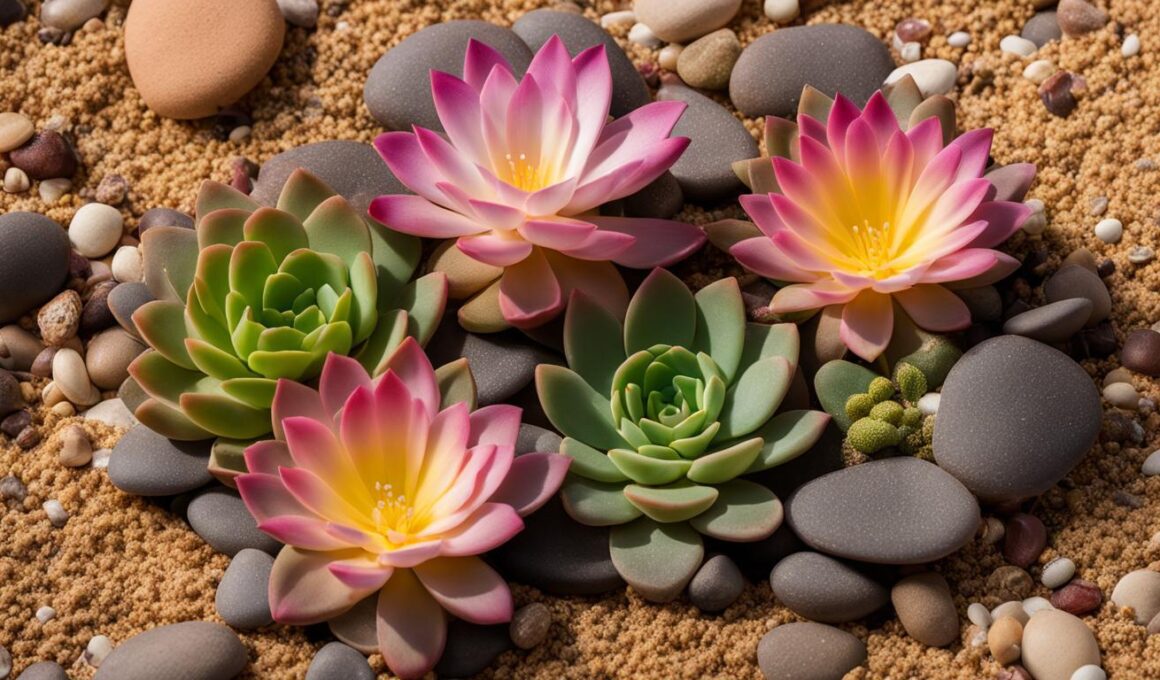Lithops, also known as living stones, are fascinating succulent plants native to southern Africa. They have evolved to survive in arid conditions, and their unique appearance resembles stones or pebbles. One of the most intriguing aspects of Lithops is their blooming season. Most Lithops species flower during the autumn and early winter, with daisy-like yellow, pale orange, or white flowers. The flowers open in the afternoon of sunny days and close in late afternoon. The blooming period usually occurs when the plants are 3-5 years old, and some species may have a faint scent.
Post Summary
- Lithops are native to southern Africa and have evolved to survive in arid conditions.
- Most Lithops species flower during autumn and early winter, with daisy-like yellow, pale orange, or white flowers.
- The blooming period usually occurs when the plants are 3-5 years old.
- Lithops flowers open in the afternoon of sunny days and close in late afternoon.
- Some Lithops species may have a faint scent.
Factors Affecting Lithops Flowering
Lithops, also known as living stones, have a unique blooming season that is influenced by several factors. Understanding these factors is crucial for ensuring the successful flowering of these fascinating succulent plants.
One of the key factors affecting Lithops flowering is their growth cycle. During the summer, Lithops enter a semi-dormant or dry period, mimicking the arid conditions of their natural habitat. It is important to avoid overwatering during this time as the plants rely on limited rainfall. In the fall, the fissure between the leaves begins to open, signaling active growth. This is the time to resume watering, allowing for deep watering and then allowing the soil to dry out completely before watering again. By following this natural growth cycle, you can promote healthy flowering in your Lithops.
Another critical factor for Lithops flowering is providing the right environmental conditions. These plants thrive in bright light, so placing them on a sunny windowsill that receives 4-5 hours of direct sunlight, preferably in the morning, or with partial shade in the afternoon, is ideal. Additionally, Lithops need well-drained soil, similar to cacti. You can improve drainage by adding gritty materials like sharp sand, perlite, or decomposed granite to regular houseplant potting mix or using cactus potting mix. Proper lighting and well-drained soil create the optimal conditions for Lithops to bloom.
“Understanding the factors that influence Lithops flowering is key to their successful cultivation. By following their growth cycle and providing the right environmental conditions, you can encourage these unique plants to bloom and enjoy their delicate flowers.”
Factors Affecting Lithops Flowering
| Factors | Effect |
|---|---|
| Growth cycle | Follow the natural growth cycle, including the dry period in summer and active growth in fall, to promote flowering. |
| Environmental conditions | Provide bright light and well-drained soil to create the optimal conditions for Lithops to bloom. |
By understanding and addressing the factors that affect Lithops flowering, you can enhance the chances of successful blooming. Following the natural growth cycle, providing proper lighting, and ensuring well-drained soil will create the optimal conditions for these fascinating plants to showcase their beautiful flowers. With the right care and attention, you can enjoy the unique charm of Lithops in bloom.
Cultivating Lithops for Blooming Success
Cultivating Lithops requires specific care to ensure blooming success. These unique plants thrive in bright light, so it’s important to place them in a well-lit area. A sunny windowsill that receives 4-5 hours of direct sunlight, preferably in the morning or with partial shade in the afternoon, is an ideal location for your Lithops.
To provide optimal growing conditions, it’s crucial to use well-drained soil for Lithops. Similar to cacti, they prefer soil that allows excess water to quickly drain away. You can achieve this by adding gritty materials like sharp sand, perlite, or decomposed granite to regular houseplant potting mix. Alternatively, using a cactus potting mix can also improve drainage and create a suitable environment for your Lithops.
“Lithops thrive in bright light, well-drained soil, and require proper watering techniques for successful blooming. Mimicking their natural habitat is key to their overall health and blooming success.”
Proper watering is crucial for the health and blooming of your Lithops. Overwatering is the most common cause of plant demise, so it’s important to water your Lithops correctly. Follow their natural growth cycle by watering deeply but infrequently. Allow the soil to completely dry out between waterings, as Lithops are adapted to arid conditions and prefer a dry period.
Summary
To cultivate Lithops for blooming success, provide them with bright light, well-drained soil, and water them correctly. Mimicking their natural habitat by choosing a sunny location, using well-draining soil, and following their growth cycle will help your Lithops thrive and produce beautiful flowers during their blooming season.
Remember, Lithops are unique plants that require specific care. By creating the optimal conditions for them, you can enjoy the delicate and beautiful blooms that these living stones produce.
Varieties of Lithops That Bloom in Different Seasons
If you’re interested in adding some variety to your Lithops collection, there are several different varieties that bloom during different seasons. Understanding the blooming seasons of these varieties can help you plan your garden and enjoy a continuous display of colorful flowers throughout the year.
One popular variety is Lithops aucampiae, which tends to bloom in late summer or early fall. This variety features beautiful yellow or white flowers that add a vibrant touch to any garden. Another variety, Lithops dorotheae, produces annual yellow flowers and showcases a creamy pale green coloring. This variety is a favorite among collectors for its unique appearance and reliable blooming season.
If you’re looking for a variety that originates in Namibia, Lithops fulviceps is a great choice. This variety flowers with either white or yellow blooms and can add a touch of elegance to your garden. Keep in mind that while most Lithops species flower during the autumn and early winter, there are some varieties that may have different blooming seasons, such as spring or early summer, depending on the specific variety.
Lithops Varieties and Their Blooming Seasons
| Variety | Blooming Season |
|---|---|
| Lithops aucampiae | Late summer or early fall |
| Lithops dorotheae | Annual bloomer |
| Lithops fulviceps | Autumn to early winter |
| Other Varieties | Varies depending on the variety |
This table provides a summary of some popular Lithops varieties and their respective blooming seasons. Keep in mind that the blooming season can be influenced by various factors such as climate, growing conditions, and individual plant health. It’s always a good idea to research specific varieties and consult with local experts or experienced gardeners to get the most accurate information about blooming seasons in your area.
With a diverse range of Lithops varieties available, you can create an enchanting garden that showcases a stunning display of colorful flowers all year round. Whether you prefer the vibrant yellow blooms of Lithops aucampiae or the delicate elegance of Lithops fulviceps, there’s a variety for every gardener’s preference. Take the time to explore different Lithops varieties and their blooming seasons to curate a collection that will bring joy and beauty to your garden.
Conclusion
Lithops are truly remarkable plants that can bring a touch of wonder to any garden. By understanding their blooming season and implementing the right care techniques, you can ensure successful flowering and enjoy the beauty of their daisy-like flowers.
To optimize the blooming of your Lithops, it’s important to mimic their natural habitat. Provide them with plenty of bright light by placing them on a sunny windowsill that receives 4-5 hours of direct sunlight. Remember to use well-drained soil, similar to what you would use for cacti, and add gritty materials like sharp sand or perlite to improve drainage. And most importantly, water your Lithops correctly. Deep watering, followed by allowing the soil to completely dry out between waterings, is the key to preventing overwatering, which is the main cause of plant demise.
By following these blooming tips, you can enhance the growth and flowering of your Lithops. These unique plants will reward you with their delicate and stunning blooms, adding a touch of charm and elegance to your garden. Happy gardening!
FAQ
What is the blooming season of Lithops?
Most Lithops species flower during the autumn and early winter.
What color are Lithops flowers?
Lithops flowers can be yellow, pale orange, or white.
When do Lithops open and close their flowers?
Lithops flowers open in the afternoon of sunny days and close in late afternoon.
How old do Lithops need to be to start blooming?
The blooming period usually occurs when the plants are 3-5 years old.
Do Lithops flowers have a scent?
Some Lithops species may have a faint scent.
What factors influence the flowering of Lithops?
Factors such as the growth cycle and proper watering techniques can influence the flowering of Lithops.
How should Lithops be watered during the blooming season?
Lithops should be watered deeply but infrequently, allowing the soil to completely dry out between waterings.
Where should Lithops be placed for optimal blooming?
Lithops thrive in bright light and should be placed on a sunny windowsill that receives 4-5 hours of direct sunlight.
What type of soil is best for cultivating Lithops?
Lithops prefer well-drained soil, similar to cacti, and adding gritty materials to regular houseplant potting mix can improve drainage.
Are there different varieties of Lithops that bloom in different seasons?
Yes, there are numerous varieties of Lithops, and some may have different blooming seasons depending on the variety.
Will Splitting Lithops Affect Their Blooming Season?
Identifying lithops splitting may not affect their blooming season. Splitting is a natural process in lithops, and it’s normal for them to split as they grow. It’s more important to provide the right growing conditions and not disturb the plants during their dormant period for successful blooming.









